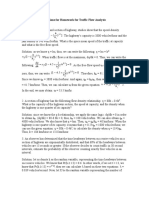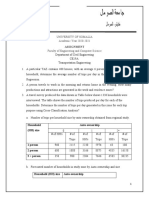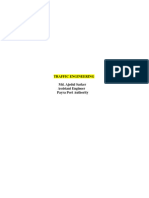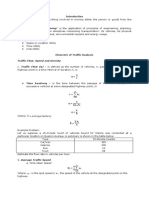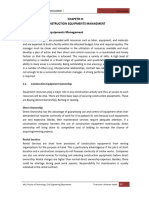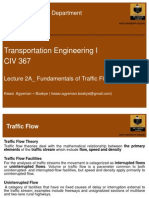Basic Elements of Highway Traffic Analysis
Basic Elements of Highway Traffic Analysis
Uploaded by
Mohammed Shah WasiimCopyright:
Available Formats
Basic Elements of Highway Traffic Analysis
Basic Elements of Highway Traffic Analysis
Uploaded by
Mohammed Shah WasiimOriginal Description:
Copyright
Available Formats
Share this document
Did you find this document useful?
Is this content inappropriate?
Copyright:
Available Formats
Basic Elements of Highway Traffic Analysis
Basic Elements of Highway Traffic Analysis
Uploaded by
Mohammed Shah WasiimCopyright:
Available Formats
Basic Elements of Highway Traffic Analysis The functional effectiveness of a highway is measured in terms of its ability to assist and
accommodate the flow of vehicles with both safety and efficiency. In order to measure its level of effectiveness, certain parameters associated with the highway must be measured and analysed. These include: Quantity of traffic Type of vehicles within the traffic stream Distribution of flow over a period of time (usually 24 hrs) Average speed of the traffic stream Density of the traffic flow This process of examination is termed traffic analysis. The traffic flow, q, is a measure of the volume of traffic on a highway, is defined as the number of vehicles, n, passing some given point on the highway in a given time interval, t, i.e.:
q= n vehicles per unit time. t
The number of vehicles on a given section of highway can also be computed in terms of the density (or concentration) of the traffic as follows:
k= n where k is a measure of the number of vehicles, n, l
occupying a length of roadway, l.
For a given stretch of road containing k vehicles per unit length l, the average speed of the k vehicles is termed the space mean speed u.
u=
( 1 n)
t
i=l
n n n l l qk = = = = u t l t n t
Flow equals speed times density
q = uk
This constitutes the basic relationship between traffic flow, space mean speed and density.
You might also like
- Solutions For Homework For Traffic Flow AnalysisDocument5 pagesSolutions For Homework For Traffic Flow AnalysisJames Mellan0% (1)
- University of Somalia Academic Year 2020-2021: AssignmentDocument3 pagesUniversity of Somalia Academic Year 2020-2021: AssignmentFuaad Abdirizak ElmiNo ratings yet
- Lecture Set 02 Road Vehicle PerformanceDocument56 pagesLecture Set 02 Road Vehicle PerformanceAbdullah SimpsonNo ratings yet
- Traffic Characteristics and ShockwavesDocument84 pagesTraffic Characteristics and ShockwavesNala A.No ratings yet
- Speed Spot StudiesDocument16 pagesSpeed Spot StudiesLuqman YusofNo ratings yet
- Ce123-Trip Generation and Attraction (Final)Document48 pagesCe123-Trip Generation and Attraction (Final)Vicces P. EstradaNo ratings yet
- Basic Elements of Transportation PlanningDocument3 pagesBasic Elements of Transportation Planningnouri100% (1)
- Geometric Design For Highways and Railways Including Cross Sections Horizontal and Vertical Alignments Super Elevation and Earthworks - CompressDocument23 pagesGeometric Design For Highways and Railways Including Cross Sections Horizontal and Vertical Alignments Super Elevation and Earthworks - Compress201240290No ratings yet
- Traffic EngineeringDocument24 pagesTraffic EngineeringLife StairNo ratings yet
- WORKED EXAMPLES On Traffic EngringDocument7 pagesWORKED EXAMPLES On Traffic EngringSolomon Eluma100% (3)
- 4.4 - Traffic AssignmentDocument32 pages4.4 - Traffic Assignmentعبداللّه السويطيNo ratings yet
- Traffic EngineeringDocument3 pagesTraffic EngineeringhulyodiesNo ratings yet
- Lecture 13 - Vertical AlignmentDocument20 pagesLecture 13 - Vertical AlignmentSesay AlieuNo ratings yet
- TR 323 Two-Lane HighwaysDocument36 pagesTR 323 Two-Lane HighwaysJames LaurentNo ratings yet
- Lecture 7 - Traffic Stream Characterstics - IIDocument15 pagesLecture 7 - Traffic Stream Characterstics - IIBasoz Arif AhmadNo ratings yet
- Unit 12 ActivityDocument1 pageUnit 12 ActivityJoshua John JulioNo ratings yet
- Topic 9 - Hauling and Mass Curve DiagramDocument14 pagesTopic 9 - Hauling and Mass Curve DiagramNicholas Bonn SingNo ratings yet
- Chapter 3: Geometric Design of Highways: D Ep Artm Ent of Civil Engineering, Ambo UniversityDocument27 pagesChapter 3: Geometric Design of Highways: D Ep Artm Ent of Civil Engineering, Ambo UniversityTarmok Hirpo100% (1)
- HW8 Solution NenerPlanteDocument4 pagesHW8 Solution NenerPlanteVishal BabuNo ratings yet
- "Transportation Engineering" Is The Application of Principles of Engineering, PlanningDocument17 pages"Transportation Engineering" Is The Application of Principles of Engineering, PlanningJoshua TesoroNo ratings yet
- Chapter 5-Fundamental Principles of Traffic FlowDocument2 pagesChapter 5-Fundamental Principles of Traffic Flowzeru3261172No ratings yet
- Module 3 Highway and Railroad EngineeringDocument13 pagesModule 3 Highway and Railroad EngineeringMarlo NepomucenoNo ratings yet
- Chapter 3 - Construction Equipments ManagmentDocument13 pagesChapter 3 - Construction Equipments ManagmentIbrahim AbdiNo ratings yet
- Chapter 1Document38 pagesChapter 1yuy ihiyiyjdhNo ratings yet
- 06 CE 122 Intersection Design & AnalysisDocument21 pages06 CE 122 Intersection Design & AnalysisJan Kenneth BarazonNo ratings yet
- PDFDocument100 pagesPDFaditya kumawatNo ratings yet
- Introduction To Highway and Railway EngineeringDocument19 pagesIntroduction To Highway and Railway EngineeringRonnel BernabeNo ratings yet
- Ce3201 L3 02 PDFDocument28 pagesCe3201 L3 02 PDFKrisha Ann M. Mendoza100% (1)
- Garber 5e SI ISM Chapter 03Document16 pagesGarber 5e SI ISM Chapter 03Hanara TechnologyNo ratings yet
- Geometric Design of Highways Part 2 PDFDocument11 pagesGeometric Design of Highways Part 2 PDFjun junNo ratings yet
- Homework No. 2Document3 pagesHomework No. 2Belal AL QaisiNo ratings yet
- Rse Accident Analysis Unit 2Document25 pagesRse Accident Analysis Unit 2Pavan uttej RavvaNo ratings yet
- Lecture - No. 8Document33 pagesLecture - No. 8Mohammed SaffariniNo ratings yet
- CE 4211 Module 2 Unit 1 Part 1Document19 pagesCE 4211 Module 2 Unit 1 Part 1dalanginjerichoNo ratings yet
- Transport Planning Chapt 3 Basic Elements of Highway Traffic AnalysisDocument51 pagesTransport Planning Chapt 3 Basic Elements of Highway Traffic Analysisskalema34No ratings yet
- Geometric Design of Highways - Part 1Document14 pagesGeometric Design of Highways - Part 1Ronnel BernabeNo ratings yet
- Lecture 5Document15 pagesLecture 5Hussein OmranNo ratings yet
- Traffic Flow ModelDocument7 pagesTraffic Flow ModelRefisa JiruNo ratings yet
- UEMX 3813 Highway and Transportation: Lecture 3: Highway Capacity and Level-of-Service Analysis Ir - Dr. Khoo Hooi LingDocument60 pagesUEMX 3813 Highway and Transportation: Lecture 3: Highway Capacity and Level-of-Service Analysis Ir - Dr. Khoo Hooi LingMOBA UNINo ratings yet
- 3 1 Sight DistancesDocument2 pages3 1 Sight DistancesSunny MarientesNo ratings yet
- Traffic Engineering Studies - Part6 PDFDocument6 pagesTraffic Engineering Studies - Part6 PDFعلي يحيى الاريانيNo ratings yet
- 2A - Fundamentals of Traffic FlowDocument18 pages2A - Fundamentals of Traffic FlowKwasi Agyeman-Boakye100% (1)
- Week 1 Principles of Transportation EngineeringDocument61 pagesWeek 1 Principles of Transportation EngineeringMayvrick SangacenaNo ratings yet
- Transpo, Min, Rail, Traffic, PortsDocument57 pagesTranspo, Min, Rail, Traffic, PortsGraciella Angela NebresNo ratings yet
- 2B - Fundamentals of Traffic FlowDocument16 pages2B - Fundamentals of Traffic FlowKwasi Agyeman-BoakyeNo ratings yet
- ReportingDocument42 pagesReportingBarbeth Ragusta CampoganNo ratings yet
- Unit 5 Travel Demand ForecastingDocument26 pagesUnit 5 Travel Demand ForecastingPrince AJNo ratings yet
- Traffic Assighment 1Document11 pagesTraffic Assighment 1Gedion Woldesenbet100% (1)
- Stopping Sight Distance For Horizontal Surfaces: Reaction Distance Braking DistanceDocument43 pagesStopping Sight Distance For Horizontal Surfaces: Reaction Distance Braking DistanceDebbie Abaoag CariñoNo ratings yet
- Ecv 401 Highway Engineering 1 - 2014Document32 pagesEcv 401 Highway Engineering 1 - 2014Daniel Kariuki100% (1)
- Introduction To Highway Engineering: 1. Importance of TransportationDocument7 pagesIntroduction To Highway Engineering: 1. Importance of TransportationFrancis AguisandaNo ratings yet
- Worksheet & AssignmentDocument2 pagesWorksheet & AssignmentAdnan Shafi100% (3)
- Traffic AssignmentDocument19 pagesTraffic Assignmentレルス ツンデ100% (1)
- Forecasting Travel DemandDocument3 pagesForecasting Travel DemandCarl John GemarinoNo ratings yet
- 1 Geological Formation of Soils and TypesDocument48 pages1 Geological Formation of Soils and TypesMuaz HararNo ratings yet
- CVLE 463: Transportation Planning & Traffic Engineering: Fall 2021/202Document39 pagesCVLE 463: Transportation Planning & Traffic Engineering: Fall 2021/202Amira HachemNo ratings yet
- Traffic Flow FundamentalsDocument9 pagesTraffic Flow Fundamentalspatriciaperenal19No ratings yet
- Highway Engineering I: Chapter Two Introduction To Traffic EngineeringDocument25 pagesHighway Engineering I: Chapter Two Introduction To Traffic Engineeringsirajt300No ratings yet
- CH-3 Fundamental Principle of Traffic FlowDocument9 pagesCH-3 Fundamental Principle of Traffic FlowNahili wondimuNo ratings yet
- Neues verkehrswissenschaftliches Journal - Ausgabe 16: Capacity Research in Urban Rail-Bound Transportation with Special Consideration of Mixed TrafficFrom EverandNeues verkehrswissenschaftliches Journal - Ausgabe 16: Capacity Research in Urban Rail-Bound Transportation with Special Consideration of Mixed TrafficNo ratings yet
- Bibliography: (James, 2011)Document1 pageBibliography: (James, 2011)Mohammed Shah WasiimNo ratings yet
- Duties of Laboratory TechnicianDocument1 pageDuties of Laboratory TechnicianMohammed Shah WasiimNo ratings yet
- Gallop RacerDocument18 pagesGallop RacerMohammed Shah WasiimNo ratings yet
- JFDSJFDocument1 pageJFDSJFMohammed Shah WasiimNo ratings yet
- HTTPDocument7 pagesHTTPMohammed Shah WasiimNo ratings yet
- Details On The Month of ShabanDocument5 pagesDetails On The Month of ShabanMohammed Shah WasiimNo ratings yet
